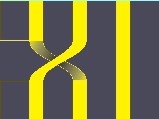

 To produce a (3-)braid we need 3 strings of chords, one left, one in the middle,
and one to the right. Then these strings move downwards, thereby changing positions repeatedly.
To produce a (3-)braid we need 3 strings of chords, one left, one in the middle,
and one to the right. Then these strings move downwards, thereby changing positions repeatedly.
|
However, what is the "essence" of a braid. If one takes a braid, leaves top and bottom
fixed, but changes the placement of the strings between without cutting any of them,
the resulting is obviously supposed to be the "same" braid. But two different representations
of the same braid may have different descriptions.
For example, obviously the braids "AA'B" can be transformed into the braid "1B1".
So both are different representations of the same braid.
Or, the braid ABA equals the braid BAB. It turns out that any two representations of the same braid cen be transformed into each other by repeatedly applying a few simple transformations: |
 AA'B |
 1B1 |
 ABA |
 BAB |
Although that, starting with a long encoding, reducing it using the laws above
is relatively easy, it is not at all easy to decide whether two given encodings
represent the same braid. The reason for that is that in order to transfrom one encoding
into another one, in most cases we have to lengthen the encoding first, and only after some
time would reduce the length to obtain the other encoding.
Take the following example:
BAABA'
=
BAABA'B'B
=
BAABA'B'A'ABAA'
=
BAABA'B'A'BABA'
=
BAB'BABA'B'A'BABA'
=
BAB'BABB'A'B'BABA'
=
BAB'ABAB'A'B'BABA'
=
BAB'ABAB'A'ABA'
=
BAB'ABAB'BA'
=
BAB'ABAA'
=
BAB'AB